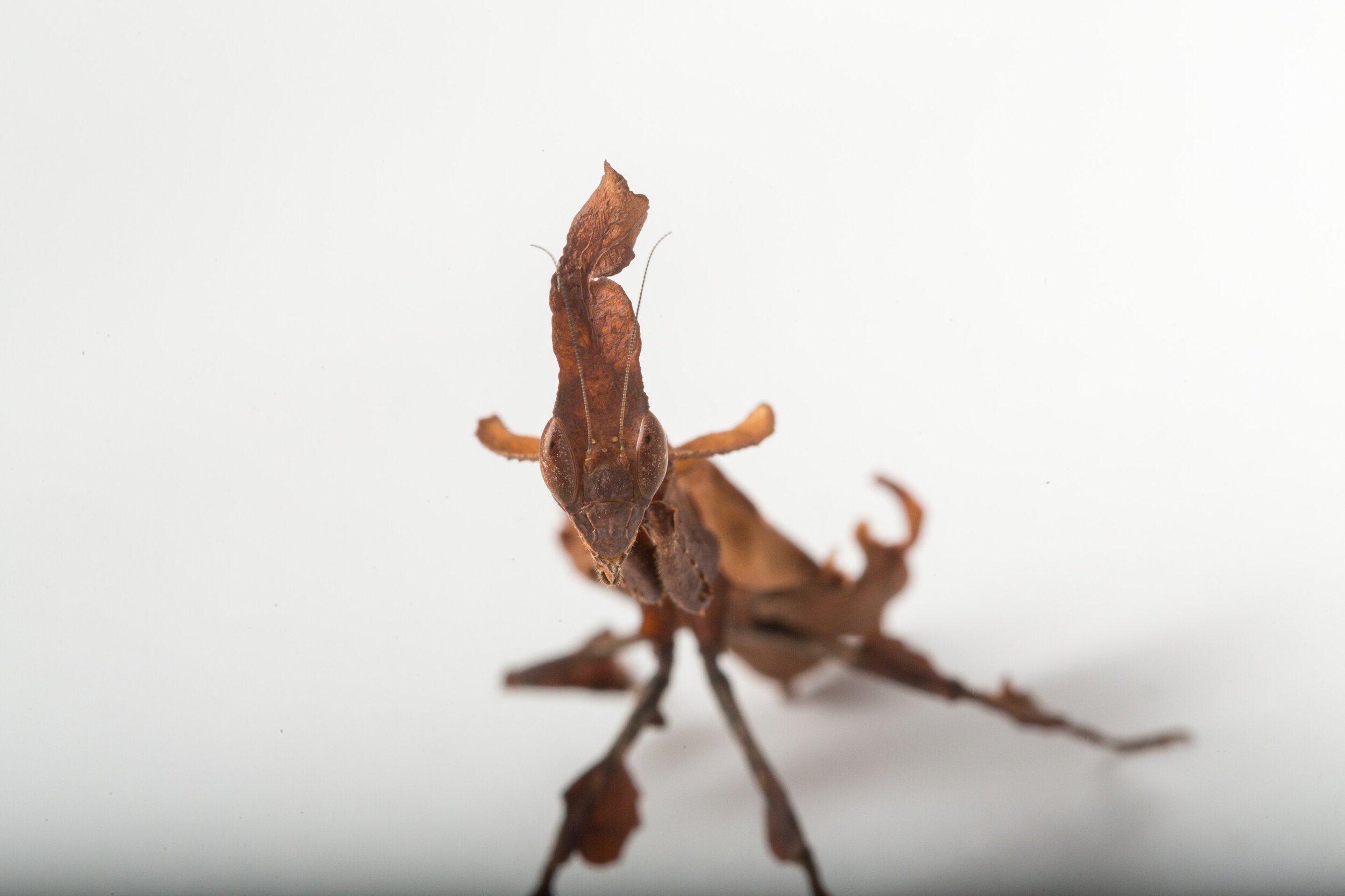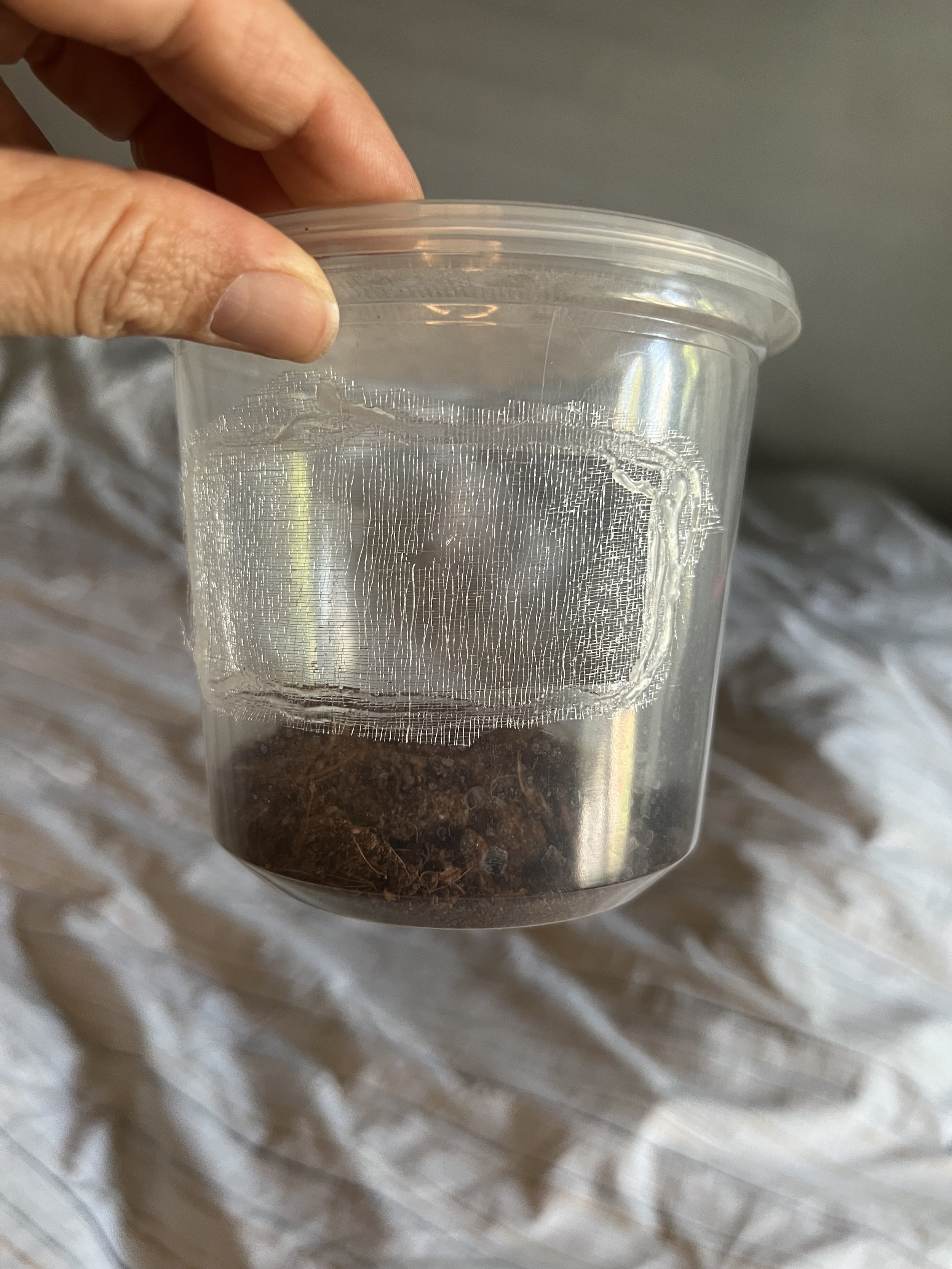Ghost Mantis Care Sheet (Phyllocrania paradoxa)
Care Instructions
Ghost Mantis
Introduction:
The Ghost mantis is one of my favorite, stand by praying mantis species! Why? Because I think they are the absolute best choice for new mantis keepers. They are one of the easiest of the exotic species to keep, but yet they still look very exotic and unique. They do not require highly specialized humidity or temperature care like some of the other exotic species.
The Ghost mantis has a latin name of: Phyllocrania paradoxa. They are a medium sized mantis that originally come from Africa. Their leaf like body and features help them camouflage perfectly in their typical surroundings of dry, weathered leaves. They can be light brown, dark brown, almost black, tan, dark green, light green, etc.
Ghost mantis. Phyllocrania paradoxa
Feeding:
L2-L4: Feed Hydei fruit flies.
Offer 2-3 fruit flies every other day. Increase as needed and as they grow. You will be able to tell if your nymph needs more- watch how fast they catch and eat when you add them in. PRO TIP: Also keep an eye on their little abdomen area- when it looks flat, its time to feed and when it looks more plump and full they are well fed.
There are two types of flightless fruit flies that are used for feeding mantids.
Drosophila hydei- small black flightless fruit fly
Drosophila melanogaster- super tiny brown flightless fruit fly
We ship L2 Ghost mantids (L2= they have molted two times) and they are eating Hydei fruit flies, so that is what I recommend to continue feeding. Hydei can be purchased usually at any local reptile or aquarium store (they are used to also feed frogs and fish). Do NOT buy melanogaster for your Ghost mantis nymphs, as these will be way too small for them.
Or, online at:
www.JoshsFrogs.com- get the “Producing Flightless Drosophila Hydei Fruit Fly Culture” for $8.99
Please make sure you have these on hand before your Ghost mantis arrives to you.
There is a trick to getting the fruit flies from their container into the mantis container! Fruit flies will come out of their container FAST once the lid is opened! Tap the fruit fly container down on a hard surface (table, counter, etc.) BEFORE you open their lid. :) This makes all the fruit flies fall to the bottom so you have more time to open the lid without tons coming out. Open mantis container, tap fruit flies into mantis container and then close lid quickly!
When your mantis molts a few more times, it will be time to increase the size of their food. We do NOT recommend crickets. These will truly be the death of your mantis (IMHO), so please NEVER feed them crickets. Instead, they can eat houseflies, blue bottle flies, or red runner roaches as they grow.
L5- Adult: Feed Houseflies, Red Runner Roaches or Blue Bottle Flies
Houseflies:
You will buy these already as the brown pupae case. They will come in a small container and you will need to put them in a larger deli cup WITH ventilation. Without a ventilated container, the pupae will mold. Leave at room temperature and they will hatch out. they must be left out at room temperature. Once they hatch you can place them in the refrigerator to "calm them down" so they don't fly away and then you can grab a few to put into your mantis enclosure.
Small/Medium Red Runner Roaches:
Blue Bottle Flies:
These food sources above are not as readily accessible feeders so we highly recommend ordering them in advance.
NEVER EVER FEED CRICKETS! We do not support crickets as feeders for mantises due to the high bacteria load that crickets carry in their gut- usually from their enclosures.
Misting/Water
Lightly mist the inside walls and bottom of your mantis container every day with bottled SPRING water (please NOT TAP!) in a spray bottle. Sometimes they will drink the water droplets on the side, sometimes they won’t and sometimes they will drink the mist off their head or raptors- this is very cute!. Misting will keep the humidity inside the container up. (This will also help with molting). AGAIN, no tap water.
These are the spray bottles that I use:
WATER!! DO NOT USE TAP WATER! Your mantis needs to be lightly sprayed every day with bottled spring water only. I use Arrowhead Spring water.
ENCLOSURE
Generally, your mantis enclosure should be at least twice as wide and three times as tall as the mantid, but not much larger than that. If the enclosure is too large, they will have a hard time finding its prey. If the enclosure is too small, they will not have enough room to molt successfully.
There are hundreds of ideas/options out there. With a quick Google search, you will see examples of very simple set ups, similar to the container your mantis came in, to extremely extravagant enclosures complete with greenery, timed misters, sticks, leaves and more!
I prefer to use modified plastic deli cups. I like to cut out the top of the deli cup and hot glue mesh fabric over it to increase ventilation. I use tulle, organza, or fine mesh. I also like to cut a rectangle out from the side of the container, near the bottom, and cover this with mesh too. This gives the container a way for air to come in the bottom and out the top and vice versa. (Photo below). Exotic mantis like ventilation and air flow, so please keep this in mind when choosing or modifying your enclosure.
Modified deli cup where I have cut out a section on the size of the cup and hot glued organza fabric over it for extra ventialtion
These are also amazing, full mesh enclosures that I love and recommend:
For nymphs and smaller species:
RESTCLOUD Mini Butterfly Habitat, Insect Mesh Cage, Bug Terrarium Pop Up 7.5" x 11" Tall
For larger species:
RESTCLOUD Insect and Butterfly Habitat Cage Terrarium Pop-up 12 X 12 X 12 Inches
Everyone wants to get these all glass or plexi terrariums and while they are pretty to look at, they do not truly meet a praying mantis' most essential requirements:
1. ventilation and 2. gripping surfaces.
So if you must use a glass or plexi enclosure (and again, I do not recommend) I would highly recommend that you modify the top mesh with an additional fabric (tulle, organza or a finer mesh), as the metal mesh usually used for these types of enclosures are not good for the tarsus (end of the legs/raptors, what they use to grip) and does not allow them a strong grip to hang upside down and molt. With large species this is a HUGE concern. The larger the species the bigger the challenge it is for them to molt successfully and not fall during molting due to their weight while hanging upside down. Falling during molting is a common issue with mantids, so making their gripping surface that they will hang upside down from is extremely important.
In addition to adding some finer mesh fabric over the top by hot glueing to the inside, you will also want to add some mesh to the sides (left, right and back) to give the mantis more gripping surface and the ability to get to the top of the enclosure to hang upside down. Glass or Plexi enclosures are too slick for mantids to climb up, so I always recommend covering the sides with some gripping fabric. Basically you are trying to convert your enclosure to be more like this one:
RESTCLOUD Mini Butterfly Habitat, Insect Mesh Cage, Bug Terrarium Pop Up 7.5" x 11" Tall
with more mesh gripping surfaces on the sides.
But again, I really only recommend full mesh enclosures like the ones linked above.
Here are important things to remember when it comes to creating a mantis enclosure:
This is the most important! Mantids need VENTILATION, so be VERY aware of the amount of air that can pass through your enclosure. Tiny holes alone will not suffice, which is why I recommend the modified deli cup container described above that has a full mesh top and holes all over the sides, OR the mesh enclosure linked above on Amazon.
The next equally important thing is that mantids need something to “grip” or hang on to- especially at the top of the container. A lot of mantis keepers will also add sticks or even hot glue mesh screen, organza or tulle fabric to the inside sides/walls of their enclosure to ensure they have enough grip. You will see your mantis hang out most of the time wherever there is grip for them- usually on the top. When you upgrade to a larger container, be sure to provide mesh for them to grip on to on the top and sides. You can use tulle, fine mesh, organza (this is what I use), or non-slip rug gripper. This is very important. I see a lot of glass enclosures out there for mantis with NO grip added to the sides, only on top and this is a big no-no. Plus glass enclosures provide little ventilation. Mantids need to be able to easily grip and climb up the sides of their enclosure, as well as hang from the top. If you use the mesh container from Amazon linked above, you don't need to worry about gripping surface because the entire thing is made of mesh- which mantises love and is easy to grip on to.
Mantids also need humidity, so even though your enclosure will have ample ventilation, it also needs some humidity. So, there is a balance to aim for! But by simply misting them daily, you will provide enough humidity.
Decoration advice! Mantises especially love sticks, flowers and leaves! If you use any decoration in your enclosure, I recommend purchasing from a pet store or online so you know they have been cleaned and are meant to be used for pets. I do NOT recommend using plants/leaves from nature- dust, dirt, bacteria, etc can harm your mantis, so I really don’t recommend this.
I often use these two items from Amazon:
6Pcs 75cm Lifelike Dry Willow Branches Bendable Iron Wires Artificial Floral Flower Stub Stem
5. The bottom of your enclosure can be as simple as a paper towel (that is what I use!), or coconut fiber substrate by Zoo Med (Petco) is great too. Just be sure to keep it lightly moist. I honestly feel that paper towels are the easiest.
TEMPERATURE & HUMIDITY
I’m going to talk about “ideal” and “realistic” here. Mantids are most comfortable in 80-90 degrees temps because think about where they are originally from, usually hot, humid and tropical places. Some mantis keepers have a dedicated room for their mantids, so they can easily keep their room that warm. However, my mantids are in my room and that is a little hot for me and also hard to keep that warm in the winter months. Your Ghost has been kept thriving in more of a range of 74-79 degrees during the day, and about 70-74 degrees at night. I think anywhere from mid 70- mid 80’s will be fine. Here in Southern California we have mild temperatures, so I don’t really worry about it that much but other parts of the country should consider how to keep ideal temps for their enclosures. I have mini hygrometers on my mantis shelf that helps to tell me the temperature and humidity. You can buy them cheap on Amazon in a 4 pack.
This is the one I like:
Relative air humidity for Ghost is 75-85%. I have found a quick mist each day will help keep this level.
UPON ARRIVAL
Please make sure you will have Hydei fruit fly species on hand when your mantis arrives. Give your Ghost a light misting of bottled water with a spray bottle as soon as it arrives and offer 3-4 fruit flies. Then place in a quiet area of your home and just let it rest and destress from travel/shipping. Ghosts are hardy mantids, but yours is still little so I recommend to be more conservative when it first arrives and not handle it for a few days. Just the misting of water and some fruit flies and let it just chill out for a few days. After that, you can handle it a little and take it out to enjoy it.
Additional Questions?
Please feel free to contact me with any additional questions! I am here to help you! Most importantly HAVE FUN with your new pet! These are beautiful little creatures that are a lot of fun!





